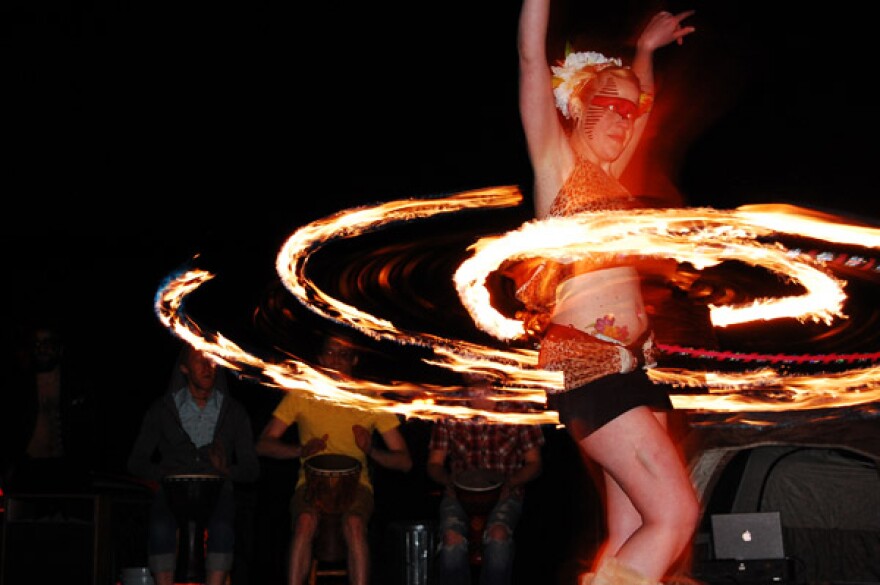The Hula Hoop is on fire…literally. The popularity of Hooping” has soared in recent years, transforming it from a groovy toy in the 1960’s to pyrotechnic performance art in the two thousands. Almost sixty years after its commercial invention, the Hula Hoop is hotter than ever.
Aztec Street has a reputation as being one of the best places in Flagstaff to Trick or Treat on Halloween. People go all out, burning cauldron fires in their driveways, walking on neon stilts and turning backyards into trails of terror.
But, this year, none of the costumed kids or their parents were expecting to see a fire-Hula-Hooping performance in the middle of Aztec Street.
"Is everybody having a good Halloween?" asks 27 year old Kayley Smith as she spins a blazing hoop of fire around her waist, arms and neck. Her audience watches in awe…from a safe distance.
"Yo, she got moves."
Smith is no amateur. She’s a performer with the local circus troupe, Circus Bacchus. She says safety is key when it comes fire hooping, right down to the clothes on your body, which tonight, for Smith, consist of a black leotard and silver lame tights.
"When you first start fire performing you start researching what fabrics are good for you, making sure that they don’t melt to your skin, that’s a good one. It’s not a fun thing you do while you’re drunk at a party."
But, it used to be…kind of.
The first commercial Hula Hoop was marketed by the Wham-O company in 1957. It was advertised as a fun activity to do at the beach or at a party. And it was an instant success. It was also instantly unclear whether the Hula Hoop was just a toy or an actual form of exercise or even sport. That question came up in 1958 when Wham-O co-inventor Arthur “Spud” Melin appeared on the game show, “What’s My Line?” where celebrity guests tried to figure out what contestants did for a living.
"And we'll start the questioning with Ms. Arlene Francis."
"Well, Mr. Melin, you look like quite a strong, young man. Do you have anything to do with the world of sports?"
"Yes."
"I think Spud is being too generous."
"He has a different idea of sport than you?"
"I believe an affirmative answer there would be misleading in the extreme and besides we want to flip a card so I’ll change it to ‘no’."
But it turns out it was more sport than toy. In the 1970’s, while kids across America began losing interest in the plastic hoop, it was slowly working its way into elite sports. In 1984, the Hula Hoop made its Olympic debut in Los Angeles in the rhythmic gymnastics competition. During the London games this summer, it was one of the most well attended events.
And even more recently, it’s become a popular - and ultra-hip - fitness class.
On this Saturday morning, a group spandex clad students have gathered at a studio in downtown Flagstaff for a Hula Hooping class. 31 year old Melissa Kashaely is one of them.
"When you really get into hoop, it’s not so much about the hips anymore as it is all the way from the toes to the fingertips," she said.
Kashaely became interested in hooping after obsessively watching YouTube videos of dramatic Hula Hoop tricks. She was bored with her regular exercise routine and decided to give hooping a spin.
"You learn a kind of muscle control that you didn’t know you had before," she said.
Paul “Dizzy Hips” Blair has some of the best hooping muscles in the business. He has to since he makes a living performing on international TV Shows and at county fairs hooping things like giant tractor tires.
"Ready for a show? I'm Dizzy Hips...Hula Hoop Man!" he shouts to the crowd at a local fair.
“Dizzy Hips”, 44, also holds the Guinness World Record for spinning the most hoops at once, 136. But, that’s hardly his most interesting hoop trick.
"I can do pretty much every sport while hooping, football, throw, catch, tennis, golf, skiing snowboarding, swimming, every sport while hula hooping," he said.
“Dizzy Hips” says there’s somewhat of a glass ceiling for male hoopers since, according to his calculations, 99 point 999 percent of all hoopers are women. And that, he says, is the kind of job security he likes.


